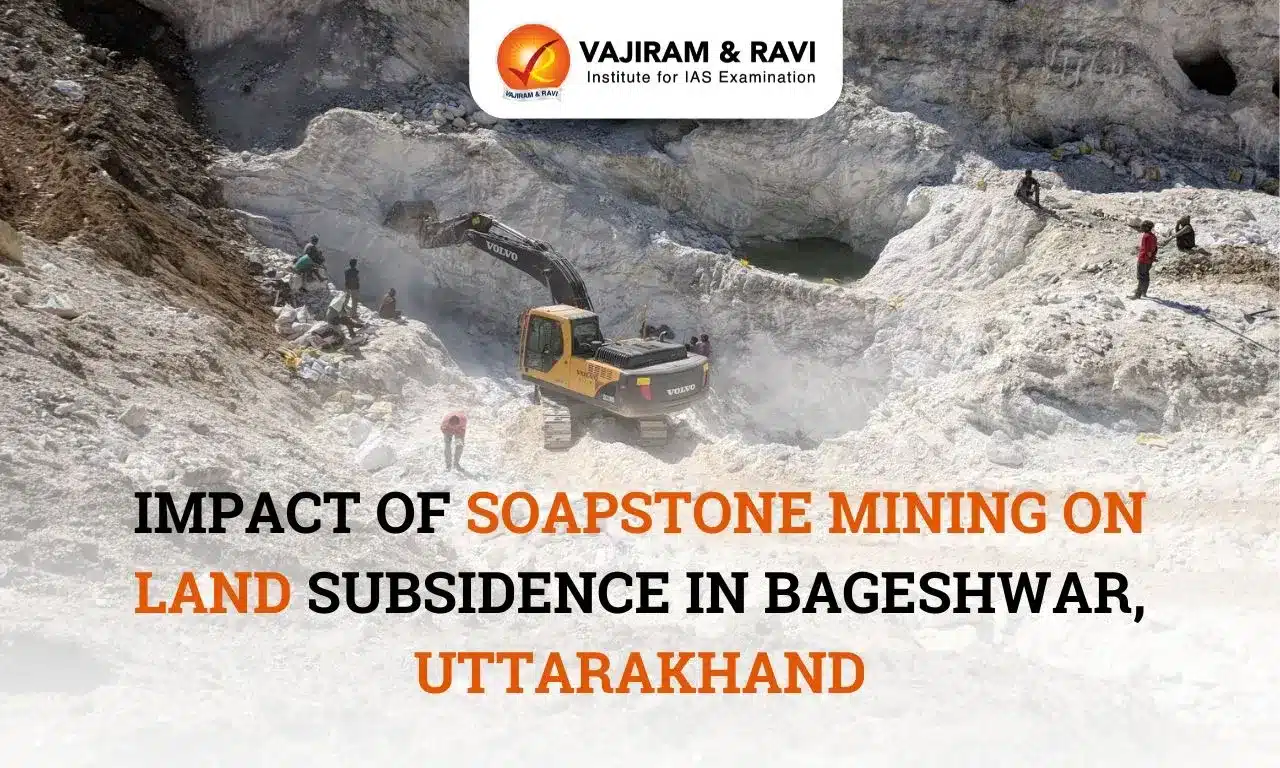What’s in today’s article?
- Why in News?
- What is Soapstone?
- Various concerns associated with Soapstone mining
Why in News?
The Uttarakhand High Court has criticized authorities for unregulated soapstone mining in Bageshwar district, which currently has over 160 mines.
The court took suo motu cognizance of a November 7, 2024 news article highlighting rampant mining in Kanda tehsil, leaving poor residents vulnerable to natural calamities.
The report submitted to the Uttarakhand HC highlighted the absence of a clear definition for “semi-mechanised mining” by both the State of Uttarakhand and the Union of India.
Environmental clearances are being granted without defined policy limits, enabling the use of heavy earth-moving equipment, which leads to severe environmental and operational challenges.
What is Soapstone?
- About
- Soapstone, also known as steatite, is a soft metamorphic rock composed primarily of talc with varying amounts of chlorite, dolomite, and magnesite.
- Its smooth, soapy texture and heat-resistant properties make it a versatile material.
- Uses
- Industrial Uses: Soapstone is widely used in industries for making sculptures, countertops, sinks, and tiles due to its durability and aesthetic appeal.
- Heat Resistance: It is used in stoves, fireplaces, and laboratory countertops because of its excellent heat resistance.
- Cosmetics and Paper: Ground soapstone serves as a filler in paper, cosmetics, and paints.
- Traditional Uses: In India, soapstone is used for making utensils, handicrafts, and idols.
- Availability in India
- Rajasthan: The largest producer, particularly in the Udaipur, Dungarpur, and Bhilwara regions.
- Uttarakhand: Notable deposits in Bageshwar, Pithoragarh, and Almora districts.
- Tamil Nadu and Karnataka: Smaller reserves also exist.
- Mining
- Soapstone mining involves extracting talc-rich rock from open-pit or underground mines.
Various concerns associated with Soapstone Mining
- Environmental Concerns
- Land Subsidence in Uttarakhand
- Land subsidence is a significant issue, with notable cases like Joshimath in 2022 and vulnerable areas like Kanda-Kanyal and Kanda in Bageshwar district.
- Subsidence, defined by NOAA as the “sinking of the ground due to underground material movement,” can result from mining, water/oil extraction, soil erosion, compaction, and earthquakes.
- Mining in lower slope areas destabilizes upper slopes, increasing vulnerability to mass movement.
- Loamy, loose soil in the region exacerbates erosion, especially during monsoons.
- Mining Impacts on Stability and Ecosystems
- Mining operations lack essential safeguards like green belts, retaining walls, buffer zones, and slope monitoring.
- These deficiencies accelerate soil erosion, destabilization, and slope failure.
- Mining and associated activities cause water scarcity, pollution, and air pollution.
- Land Subsidence in Uttarakhand
- Cultural Concerns
- Impact on Traditional Structures
- The Kumaoni Bakhli, traditional houses resilient to seismic activity, are now damaged due to subsidence and mass movement, undermining their foundations.
- These structures are a testament to local environmental and cultural adaptation over centuries.
- Damage to Cultural Sites
- The Kanda tehsil is culturally rich, with traditions of folk music, dance, and handicrafts.
- The Kalika Temple, a significant 10th-century religious site in Kanda, has developed cracks due to subsidence, threatening its historical and cultural integrity.
- Impact on Traditional Structures
Q.1. What are the environmental concerns of soapstone mining in Bageshwar?
Soapstone mining destabilizes slopes, causing land subsidence and erosion, especially in monsoon-prone loamy soils. Lack of green belts, retaining walls, and safety protocols further exacerbates the issue, impacting both ecosystems and local communities.
Q.2. How has soapstone mining affected cultural heritage in Bageshwar?
The mining has damaged traditional Kumaoni Bakhli houses and historic sites like the Kalika Temple, leading to structural cracks. These impacts threaten the region’s rich cultural heritage, including its folk traditions and historic architecture.
Last updated on June, 2025
→ UPSC Notification 2025 was released on 22nd January 2025.
→ UPSC Prelims Result 2025 is out now for the CSE held on 25 May 2025.
→ UPSC Prelims Question Paper 2025 and Unofficial Prelims Answer Key 2025 are available now.
→ UPSC Calendar 2026 is released on 15th May, 2025.
→ The UPSC Vacancy 2025 were released 1129, out of which 979 were for UPSC CSE and remaining 150 are for UPSC IFoS.
→ UPSC Mains 2025 will be conducted on 22nd August 2025.
→ UPSC Prelims 2026 will be conducted on 24th May, 2026 & UPSC Mains 2026 will be conducted on 21st August 2026.
→ The UPSC Selection Process is of 3 stages-Prelims, Mains and Interview.
→ UPSC Result 2024 is released with latest UPSC Marksheet 2024. Check Now!
→ UPSC Toppers List 2024 is released now. Shakti Dubey is UPSC AIR 1 2024 Topper.
→ Also check Best IAS Coaching in Delhi
























